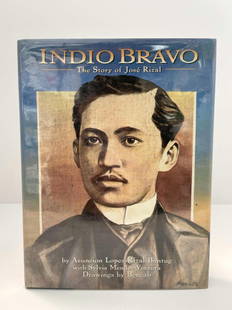
Benedicto Cabrera (b. 1942) Girl with a Salakot
Similar Sale History
View More Items in CollectiblesRelated Collectibles
More Items in Collectibles
View More


Item Details
Description
Girl with a Salakot
signed and dated 1972 (lower right)
acrylic with pen and ink
14 1/2" x 13" (37 cm x 33 cm)
PROVENANCEThe Luz Gallery
EXHIBITEDThe Luz Gallery, Larawan: 1972 Paintings by Bencab,Makati City, October 12 - 31, 1972
On the 50th anniversary of Benedicto Cabrera's 1972 Larawan exhibition at The Luz Gallery, León Gallery is delighted to present a rare, thought-provoking work from that seminal show, which manifested the artist's coming of age. That landmark exhibit would be the first of many artistic pursuits during the tumultuous 70s. It would be Bencab’s first Larawan exhibition and, interestingly, the first cultural activity after the declaration of martial rule. It was October 1972. Bencab had just returned from London after a string of successful exhibitions in various European cities. Towards the middle of that month, Bencab mounted a homecoming exhibition at the famed The Luz Gallery. It was the first cultural activity after the declaration of martial rule. The show, Larawan: 1972 Paintings by Bencab, became a rousing success. It earned critical praises and signaled the emergence of Bencab as an eminent artist—an influential maestro in a league of his own. In an April 1978 interview with Cid Reyes published in the 50th anniversary two-volume book on the artist, Bencab expounds on the origins of both the Larawan series and exhibition: "Well, ever since I came to London in 1969, I have been collecting old prints and rare books about the Philippines. I was then planning to go back to Manila for a visit and a possible exhibition, and I just hit on the idea of doing a show, which would be an approximation of the experience of browsing through an old Filipino album. So, I did these paintings, which were all based on these old photographs. The show was called ‘Larawan.’” Bencab shares in Krip Yuson and Cid Reyes' BENCAB: "I talked to the people at The Luz Gallery. They were a bit wary at first, but eventually, word got around, and interest in the paintings became very strong. At that time, no one else was attempting what I had done. But soon it started a trend, of feeding from colonial images and giving these a modern twist." Bencab's Larawan was his serious undertaking in carving his distinct creative path that, at the same time, is deeply connected with his native roots. The poet Luis Francia writes in his memoir Eye of the Fish: "…In London, Bencab quickly realized that if he followed what was current in Western art, he would always be a second-rate artist, since the impulse for such art didn't come from within, wasn't of his skin." Despite the works being created before a stormy period in Philippine history, the Larawan series possesses an inherent social relevance. Bencab shares in Yuson and Reyes' book: "They [his Manila friends] told me, 'Why, this is all very subversive,' since in a way it revealed the new masters, about whom everyone thought best to keep silent." Bencab ingeniously consolidates history, social critique, and aesthetics. Dr. Patrick Flores notes in 'Social Realism: The Turns of a Term in the Philippines' that the Larawan "exerted a strong influence in the making of social realism, given its ability to draw links between the precolonial past and the postcolonial present through the appropriation of images." Through his Larawan works, Alice Guillermo referred to Bencab as a forerunner of Philippine social realism. Several pieces in the Larawan exhibition also depict the lifestyles and costumes of the late 19th to early 20th centuries. The social commentary in these works lies in their innate power to instigate progressive discourses on the parallelism between the subjugated indio and the modern Filipino. Such is the case with the work at hand. Bencab depicts a turn-of-the-century Filipino garbed in the traditional baro't saya and wearing a salakot. Her facial expression radiates a penetrating gaze. Her stature exudes confidence. Here, the woman's defiant and dignified image connotes a bold declaration of autonomy borne out of their colonial experience; that we must no longer capitulate to foreign hegemony. Bencab shares in his interview with Reyes that the end goal of the Larawan was "to make our colonial past reflect on our present." He "wanted to show how the whole process of colonization changed the Filipino." Beyond the nostalgia evoked by the sepia-colored composition, Bencab's Larawan instills that the Filipino is a result of centuries of contact, subjugation, and struggle. Today, as our sovereignty and democracy are under an oppressively constant threat, we are in a continuous endeavor to explore, reclaim, and affirm our nationhood. Therefore, the Larawan is representative of the modern Filipino. Significantly, the semi-centennial anniversary of the Larawan exhibition happens to occur during this challenging period in our country's recent history. As a series produced in a most turbulent time, the Larawan enkindles today an unceasing assertion of our identity as stalwarts of freedom—and uncompromising resistance to defend our rightful, genuine expression of liberty and self-determination enshrined in our democratic principles. (A.M.) A Rare ‘Larawan’ from Bencab’s 1972 Inaugural Larawan Exhibition
Buyer's Premium
- 22%
Benedicto Cabrera (b. 1942) Girl with a Salakot
Estimate ₱1,000,000 - ₱1,300,000
Shipping & Pickup Options
Item located in Makati City, Metro Manila, phSee Policy for Shipping
Payment

TOP







































![[Civil War] Prostitutes & the Clap: Autograph letter signed by Ed Haughton, 2nd Maine Cavalry, to friend Charley. Braskier [Brashear] City, [Louisiana], 15 June 1864. 4 pages, 8vo. With original envelope with New Orleans stamp and red 3](https://p1.liveauctioneers.com/7226/325455/175168995_1_x.jpg?height=310&quality=70&version=1712370394)


























![George Washington Signed Discharge: Partly printed discharge document signed by George Washington, as Commander in Chief of the Armies of the United States. Newburgh, [New York], 4 January 1783. 1 page, ## x ## in. Undersigned by Washin](https://p1.liveauctioneers.com/7226/322253/173251475_1_x.jpg?height=310&quality=70&version=1710004847)


